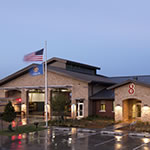Sustainable fire stations in Texas and Oklahoma are spreading like wildfire. Look no further than the portfolio of Dallas-based Kirkpatrick Architecture Studio. The firm has designed several LEED-certified fire stations in the Dallas area and others near its Norman, Oklahoma, office. Denton Station No. 7, the first LEED Gold fire station in Texas, was completed in 2007, and Norman Station No. 8, completed in 2011, was the Oklahoma’s first LEED fire station, and two newer stations await certification.
“There has been an increasing emphasis on the health and well-being of firefighters,” says David Robinson, managing director at Kirkpatrick Architecture. “The effects of the interior environment are more pronounced than in an office. Even though they are smaller in size compared to most other municipal buildings, these are the places where firefighters spend a third of their lives—on 24-hour shifts—including eating, sleeping, and working out. Also, the 24/7 nature of fire stations also means there is a pronounced need for energy efficiency.” The key drivers are operating cost containment and wellness, and it doesn’t hurt that both Denton and Norman have universities that help embed an environmental mindset into the community.
How are health and well-being achieved? It’s been heavily documented by many studies over several decades that worker productivity, lower absenteeism, and reduced fatigue as well as overall health are enhanced with natural daylighting. The design of the Norman fire station includes tubular daylighting, which transfers sunlight to interior rooms, including the bays where fire truck maintenance takes place. In all stations, the facilities’ fitness rooms are prominent features, answering a nationally documented problem associated with firefighting: cardiac disease. The US Fire Administration division of FEMA conducts national programs to promote fitness, which is more likely to occur with an on-site gym.
The less visual components of these green buildings are no less meaningful. Because the Texas-Oklahoma climate includes long, hot summers, a tight building envelope and high-efficiency cooling systems are key components of the buildings. In Denton, the use of geothermal pumps and efficient lighting translates into 35 percent less energy use for a comparable 15,000-square-foot, four-bay fire station. Norman’s three-bay station uses daylight sensors to dim lights in the apparatus bay.

The more residential design of Fire Station No. 9 helps it blend in to the neighborhood while sunshades and deep overhangs reduce solar heat gain.
On water use, both certified facilities are stingy; Norman No. 8 is landscaped with native plants that require no irrigation, and at Denton No. 7, four corrugated steel cisterns each collect 5,400 gallons from the building’s roof for landscaping use. Domestic water consumption is further reduced by 40 percent at both locations with low-flow plumbing fixtures. Eighty-five percent of carpet content in Norman is from recycled plastic and glass.
Robinson notes that in addition to the demands of similar “wear and tear” facilities, firehouses cannot be constructed with uncertain-performance components. “Failure is bad,” he says. “We are far less likely to test new products in a fire station because these are buildings that enhance public safety. Everything in the design has to facilitate that.” In addition, fire stations in this region of the country require safe rooms, where reinforced concrete walls protect first responders in violent weather—Norman served as a major command center during extremely destructive tornadoes in 2013 in nearby Moore, Oklahoma.
A third sustainable fire station, also in Norman and designed by Kirkpatrick Architecture, opened in September 2013 and is pursuing LEED certification with geothermal HVAC, sophisticated lighting controls, and stormwater controls. Yet another station, Denton No. 2, is in the design phase, and designers plan to incorporate geothermal, photovoltaic solar panels, storm-water discharge, and, of course, a tight building envelope.
Under the close budgetary scrutiny of smaller-sized cities, the decision to seek LEED certification is not necessarily an obvious one, but Robinson says it “provides assurance that we can control the green aspects on the construction side. There is a shared vision of what we are aiming for. LEED provides a communications tool so shortcuts aren’t taken.” To fiscally responsible city managers, that presumably is the spark of smart building.



